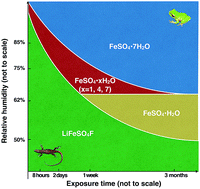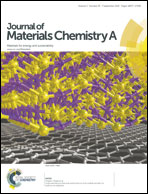Influence of relative humidity on the structure and electrochemical performance of sustainable LiFeSO4F electrodes for Li-ion batteries†
Abstract
Material abundance and eco-efficient synthetic protocols are becoming the overriding factors for developing sustainable Li-ion batteries, and hence today there is great interest in LiFePO4. The recently reported tavorite-type LiFeSO4F cathode material, which shows a redox potential of 3.6 V and a practical capacity of ∼130 mA h g−1 without the need for sophisticated carbon coating or particle downsizing, stands presently as a serious contender to LiFePO4. However, its synthesis is still not routinely reproducible. Herein, we offer a direct explanation by showing the strong effect of the room temperature relative humidity on both LiFeSO4F aging stability and its electrochemical performances. We demonstrate the complete degradation of tavorite-type LiFeSO4F into FeSO4·nH2O (n = 1, 4, 7) and LiF in environments with relative humidities greater than 62%, and also show the feasibility of triggering in situ formation of a F−-free (Li)FeSO4OH phase within the cell. This work, which we also extend to the 3.9 V triplite-type LiFeSO4F polymorph, provides a foundation for achieving the consistent production and handling of LiFeSO4F electrodes in view of large-scale manufacturing. This moisture sensitivity issue, which can be mitigated by surface treatments, is inherent to sulfate-based electrode materials and the battery community must be aware of it.



 Please wait while we load your content...
Please wait while we load your content...